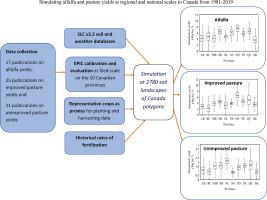Agricultural Systems ( IF 6.1 ) Pub Date : 2021-05-02 , DOI: 10.1016/j.agsy.2021.103166 Zhaozhi Wang , J.Y. Yang , C.F. Drury , Rong Jiang

|
CONTEXT
There has been a great deal of uncertainty in the reported alfalfa and pasture yields in the agricultural database as these commodities are typically used internally on farms and are not sold in the same way as other crops such as wheat, canola or corn. However, yields from alfalfa and pasture crops are important inputs (biological fixation) and outputs (feed) that can impact the estimates of agri-environmental indicators as the land area in Canada under these crops is very large. One of the indicators which uses this data is the residual soil nitrogen (RSN) which is the amount of inorganic N remaining in soils after harvest. High RSN levels can lead to impaired water quality (e.g., eutrophication) and global warming (N2O). Therefore, it is critical to obtain accurate alfalfa and pasture yield estimates. In previous versions of the Canadian Agricultural Nitrogen Budget Model (CANB), only provincial average yield values were used for alfalfa or pasture yields across all of the soils and landscapes. Soils, climates, and crop yields do vary within provinces, and a more accurate estimate of these yields over time and space is required.
OBJECTIVE
The objective of this study was to collect recent published yield data and use the Environmental Policy Integrated Climate (EPIC) to estimate yields for the 2780 soil landscapes of Canada (SLC) polygons.
METHODS
The EPIC model was used to calibrate and evaluate yields at field scale based on a total of 109, 59 and 47 treatments collected for alfalfa, improved and unimproved pasture yields, respectively, from Canadian publications. Due to satisfactory evaluation, we extended simulation to all SLC polygons based on SLC v3.2 soil and weather databases, representative crops as proxies for planting and harvesting date, and historical rates of fertilization.
RESULTS AND CONCLUSIONS
The average simulated alfalfa, improved and unimproved pasture yields were 5.00, 3.85 and 1.22 Mg ha−1, respectively over the period from 1981 to 2019. Generally, the EPIC model showed reliable predictions for alfalfa and pasture yields under variable weather, soil, and management practices.
SIGNIFICANCE
Therefore, it enabled us to provide improved estimates across soil landscapes polygons in Canada and thereby improve our agri-environmental indicator models.
中文翻译:

在1981年至2019年期间,在加拿大的区域和国家范围内模拟苜蓿和牧草的产量
语境
农业数据库中已报告的苜蓿和牧草产量存在很大的不确定性,因为这些商品通常在农场内部使用,并且销售方式与其他作物(如小麦,油菜或玉米)不同。但是,苜蓿和牧草作物的单产是重要的投入(生物固定)和产出(饲料),会影响农业环境指标的估计,因为这些作物在加拿大的土地面积非常大。使用此数据的指标之一是土壤残留氮(RSN),即收获后土壤中残留的无机氮含量。RSN含量高会导致水质受损(例如富营养化)和全球变暖(N 2O)。因此,获得准确的苜蓿和牧草产量估算至关重要。在以前的加拿大农业氮预算模型(CANB)版本中,仅苜蓿或牧场的产量在所有土壤和地貌上仅使用省平均产量值。不同省份的土壤,气候和农作物产量确实有所不同,因此需要对这些产量随时间和空间的变化进行更准确的估算。
客观的
这项研究的目的是收集最近发布的产量数据,并使用环境政策综合气候(EPIC)来估算2780个加拿大多边形土壤景观(SLC)的产量。
方法
EPIC模型基于加拿大出版物分别收集的109、59和47种苜蓿,改良和未改良牧草产量的处理方法,用于在田间尺度上校准和评估产量。由于评估令人满意,我们基于SLC v3.2土壤和天气数据库,具有代表性的农作物作为播种和收获日期以及历史施肥率,将模拟扩展到所有SLC多边形。
结果与结论
从1981年到2019年,模拟苜蓿,改良草地和未改良牧草的平均产量分别为5.00、3.85和1.22 Mg ha -1。总体而言,EPIC模型显示了在天气,土壤和气候变化的情况下苜蓿和牧草产量的可靠预测。管理实践。
意义
因此,它使我们能够对加拿大的土壤景观多边形进行更好的估算,从而改善我们的农业环境指标模型。











































 京公网安备 11010802027423号
京公网安备 11010802027423号